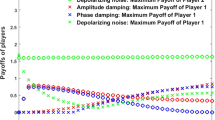Abstract
We present a family of nonlocal games in which the inputs the players receive are continuous. We study three representative members of the family. For the first two a team sharing quantum correlations (entanglement) has an advantage over any team restricted to classical correlations. We conjecture that this is true for the third member of the family as well.



Similar content being viewed by others
Notes
To be more precise, each of the quadrants corresponds to the truth table of the a < b or a > b formulation of the first game.
The differential of a solid angle, \(\Upomega\), in spherical coordinates is proportional to \(\sin\theta\). This introduces a weight function when integrating over θ and \(\varphi\).
References
Aravind P (2004) quantum mysteries revisited again. Am J Phys 72:1303–1307
Bell J (1964) On the Einstein Podolsky Rosen paradox. Phys 1:195–200
Brassard G, Broadbent A, Tapp A (2003) Multi-party pseudo-telepathy. Lect Notes Comput Sci 2478:1–11
Cabello A (2003) Greenberger–Horne–Zeilinger-like proof of Bells theorem involving observers who do not share a reference frame. Phys Rev A 68:042104
Clauser J, Holt R, Horne M, Shimony A (1969) Proposed experiment to test local hidden-variable theories. Phys Rev Lett 23:880–884
Cleve R, Høyer P, Toner B, Watrous J (2004) Consequences and limits of nonlocal strategies. In: Proceedings of the 19th IEEE conference on computational complexity, Amherst, pp 21–24
Gisin N (1999) Bell inequality for arbitrary many settings of the analyzers. Phys Lett A 260:1–3
Silman J, Machnes S, Aharon N (2008) On the relation between Bell’s inequalities and nonlocal games. Phys Lett A 372:3796–3800
Tsirelson B (1996) Lecture notes in quantum information processing. http://www.tau.ac.il/tsirel/courses/quantinf/syllabus.htmll
Tsirelson B (2007) Some extremal problems related to Bell-type inequalities. arXiv:0706.1091 [math.CA]
Vaidman L (1999) Variations on the theme of the Greenberger–Horne–Zeilinger proof. Found Phys 29:615–630
Vaidman L (2001) Tests of Bell inequalities. Phys Lett A 286:241–244
Acknowledgments
We acknowledge support from the Israeli Science Foundation (Grants No. 784/06 and 990/06), and from the European Commission under the Integrated Project Qubit Applications (QAP) funded by the IST Directorate (Contract No. 015848).
Author information
Authors and Affiliations
Corresponding author
Rights and permissions
About this article
Cite this article
Aharon, N., Machnes, S., Reznik, B. et al. Continuous input nonlocal games. Nat Comput 12, 5–8 (2013). https://doi.org/10.1007/s11047-012-9354-5
Published:
Issue Date:
DOI: https://doi.org/10.1007/s11047-012-9354-5




